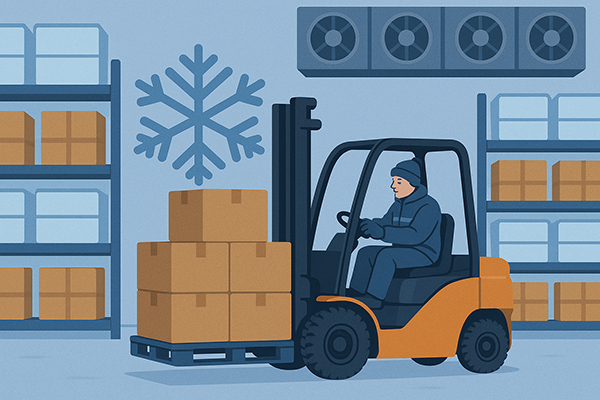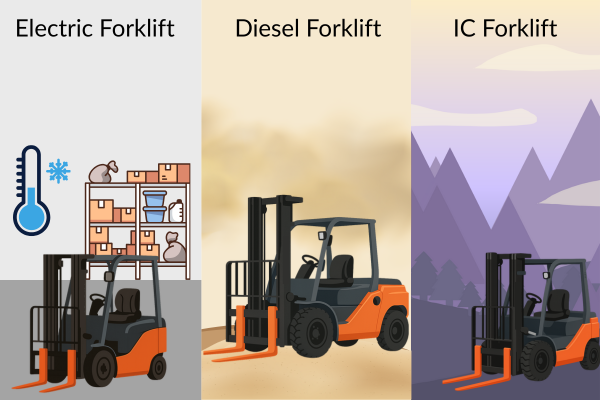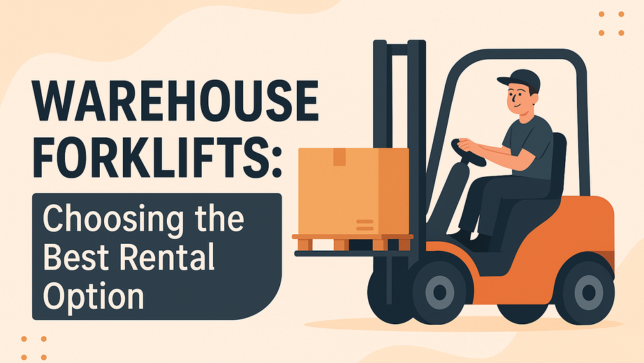When it comes to optimizing your warehouse operations, selecting the right forklift to rent can make all the difference. Whether you’re managing inventory, loading and unloading goods, or handling heavy materials, renting a warehouse forklift provides the flexibility to scale your equipment needs while avoiding the long-term commitment of ownership.
With a variety of forklifts available, it’s crucial to understand which type best suits your specific tasks. From standard counterbalance forklifts to electric models and specialized attachments, this guide will help you navigate the different options available for forklift rental, ensuring you choose the perfect machine for your warehouse needs.
Let’s dive in!
Types of Forklifts Available for Rental
Different jobs call for different forklifts. Rental providers typically offer a range of material handling equipment so you can match the forklift to your warehouse tasks. Here are the main types of warehouse forklifts you can rent and the advantages of each:

Standard Counterbalance Forklift
“Standard” forklifts refer to the common counterbalance forklifts seen in most warehouses and loading docks. They usually have a seated operator and forks extending from the front to lift pallets. Standard forklifts come in various capacities (often around 3,000 to 5,000 lbs for typical warehouse models) and can be powered by propane, diesel, or electric batteries. These forklifts are the workhorses of warehouse operations – used for loading trucks, stacking pallets, and transporting materials across the facility. They are versatile and straightforward to operate, making them a go-to choice for general warehouse needs.

Electric Forklifts
Electric forklift rentals are extremely popular for indoor warehouse use. These forklifts run on battery power instead of an internal combustion engine, which means they produce no exhaust emissions and operate much more quietly than fuel-burning models. Warehouses often prefer electric forklifts for their clean and environmentally friendly operation – there’s no gas or diesel smell and no need for ventilation of fumes. Electric models also tend to have a smaller turning radius, which is great for maneuvering in tight aisles or narrow warehouse layouts. When you rent an electric forklift, the rental typically includes the battery and charger, and maintenance support is provided by the rental company.

Internal Combustion (IC) Forklifts
Internal combustion forklifts are powered by fuel – typically propane (LPG), gasoline, or diesel. These are the classic “LP gas” forklifts you’ll see carrying heavy loads in outdoor yards or on loading docks. IC forklifts generally deliver more continuous power and higher lift capacities than equivalent electric models, making them suitable for heavy loads and outdoor operations. They also refuel quickly (swap an LPG tank or fill the diesel tank and you’re back to work in minutes), which can be an advantage for nonstop operations. If your warehouse needs a forklift for outdoor use, uneven terrain, or very heavy pallets, an IC forklift rental may be the right choice. For example, a diesel or propane pneumatic-tire forklift can handle rough surfaces and large loads that an electric might not.
However, it is important to note that IC forklifts produce exhaust and noise. If used indoors, proper ventilation is required to avoid carbon monoxide buildup. Many facilities use propane forklifts indoors with ventilation or open dock doors.

Pallet Jack Rentals
Sometimes you don’t need a full-sized forklift. For simpler tasks like moving pallets over short distances at ground level, a pallet jack rental might be the perfect solution. Pallet jacks (also called pallet trucks) are small, low-profile lifts used to jack up pallets a few inches and roll them along the floor. Rentals are available for both manual pallet jacks (hand-pumped, human-powered) and electric pallet jacks (motorized walk-behind units). A manual pallet jack is lightweight and great for occasional pallet moves or tight budgets – you simply pump the handle to raise the pallet and then push or pull it to move.

An electric pallet jack (or walkie pallet jack) has a battery-powered motor, so the operator can move heavier loads with less effort (often standing on or walking behind the unit). Electric pallet jacks are ideal if you have a lot of pallets to move across a warehouse floor regularly, as they reduce operator fatigue and increase productivity. The advantages of pallet jack rentals are their low cost and ease of use. They’re small enough to maneuver in tight spaces like the back of trucks or congested aisles. If your warehouse operation occasionally needs an extra pallet jack for inventory peaks or special projects, renting one is far cheaper than letting an owned unit sit idle most of the year.
Forklift Attachments and Accessories
One major way to expand the capabilities of a rented warehouse forklift is by using forklift attachments. Attachments are additional devices that mount onto the forklift’s carriage or forks, enabling it to handle specialized loads or perform tasks beyond standard pallet lifting.
Common forklift attachments available for rental (or that come installed on rental units) include things like fork clamps, carton clamps, bale clamps, side shifters, fork positioners, drum handlers, rotators, and more.

- A sideshifter allows the forks to move left and right hydraulically, making it easier to align with pallets without repositioning the whole forklift.
- A fork positioner lets the operator adjust the distance between forks to fit different pallet sizes on the fly.
- Clamp attachments (such as a carton clamp or paper roll clamp) use padded jaws to grab hold of loads that aren’t on pallets – like appliances, furniture, or rolls of paper – so you can lift and move them securely without forks. These attachments greatly increase the forklift’s utility for specific tasks.
When renting a forklift, ask your rental provider about available attachments and choose those that match your tasks. It’s also important to consider how the attachment might affect the forklift’s capacity and dimensions. Attachments add weight and can shift the load center, so a forklift’s effective lifting capacity will be somewhat lower with an attachment mounted (rental companies can provide you the adjusted capacity info).
(Note: Even the type of tires on a forklift can be considered a key “accessory” for your environment. For example, cushion tires vs. pneumatic tires can drastically affect where a forklift can operate. We’ll discuss this more in the next section on environmental factors.)
Key Factors to Consider When Renting a Warehouse Forklift
Renting a forklift for your warehouse is not only about picking a machine – you also need to ensure the rental terms and the equipment are the right fit for your operations.
Here are key factors and considerations when evaluating a warehouse forklift rental:
Rental Agreements and Contracts
Before signing any forklift rental agreement, take time to understand the terms and conditions. A good rental contract should clearly spell out the rental period, rates, maintenance responsibilities, insurance requirements, and any extra fees. Below are some critical contract elements to review:

Rental Duration & Rates
Determine how long you need the forklift (a day, week, month, or longer) and check the pricing structure. Rentals are typically billed by the day, week, or 4-week period.

Maintenance & Damage
Clarify who is responsible for maintenance and repairs. In many cases, forklift rentals include routine maintenance and service as part of the agreement (the rental company takes care of any mechanical issues that arise from normal use).

Insurance & Liability
Most rental companies require the renter to carry liability insurance for the equipment and operators. While the dealer typically insures the machine itself, you (or your company) will need to have insurance to cover any injuries or property damage that occur during operation.

Delivery and Pickup
Consider how the forklift will get to your warehouse. Does the rental provider offer a delivery service to drop off and pick up the equipment? Most do, for an additional fee if the distance is significant. Coordinate the delivery timing so that you have any required loading dock or forklift available on-site to unload the rental (some large forklifts might come on a flatbed).

Contract Terms & Hidden Fees
Always read the rental contract carefully before signing. Look for any additional fees or clauses, such as cleaning fees (return the forklift reasonably clean), refueling charges (commonly, you must return an LP tank full or be charged for fuel), late return fees, or minimum billing periods. Check if there’s a cancellation policy in case your needs change (for example, if a project finishes early, can you off-rent the forklift sooner?). Ensure the contract’s terms match what the sales rep or quote described. If anything is unclear, ask questions. A reputable rental provider will walk you through the contract and answer any concerns. It’s better to clarify upfront than to have surprises on your invoice later.
Lastly, a good practice is to work with rental companies that are transparent and customer-focused. They should be willing to customize terms if needed (within reason) and help you understand your obligations. The rental agreement is there to protect both parties – make sure it’s clear, fair, and aligns with your operational needs.
Load Capacity and Warehouse Requirements

One of the most critical factors in choosing the right forklift rental is ensuring the forklift’s specifications meet your warehouse requirements – especially in terms of load capacity and physical size. Here’s what to evaluate:
Load Capacity
Every forklift has a rated load capacity (for example, 3,000 lbs, 5,000 lbs, 10,000 lbs, etc.), which is the maximum weight it can safely lift at a standard load center (typically 24 inches out from the forks). It’s imperative that the forklift you rent is rated to handle the heaviest loads you intend to lift. Renting an undersized forklift can be dangerous – if you attempt to lift more than the machine’s capacity, the forklift could tip over or drop the load, risking injury and damage.
Lift Height (Mast Height)
In a warehouse, you must also consider how high you need to lift your loads. Forklifts come with different mast stages and maximum lift heights. Ensure the warehouse forklift’s mast height can reach your top rack or shelf comfortably. For example, if you have pallet racking that is 20 feet high, you’ll need a forklift (perhaps a reach truck or a high-mast counterbalance) capable of lifting to that height. Additionally, note the lowered height of the mast – can the forklift fit through doorways, under mezzanines, or inside trailers if needed? Many forklifts have a two-stage or three-stage mast; a triplex mast might be needed for higher lifts within a constrained ceiling height. Also keep in mind that as lift height increases, a forklift’s effective capacity decreases (due to the leverage and stability factors).
Aisle Width and Maneuverability
Evaluate the physical layout of your warehouse. How wide are the aisles where the forklift will operate? This determines the type and size of forklift that will work. A standard counterbalanced forklift usually needs a wider aisle to turn (often 11-14 feet or more, depending on the model). If you have narrow aisles, you might need a specialized narrow aisle forklift or reach truck.
Warehouse Layout Considerations
Think about other aspects of your facility that relate to the forklift’s dimensions. Ceiling height is an obvious one for mast clearance. Also, will the forklift need to enter shipping containers or trailers? If so, ensure the overhead guard can clear the entry and that the forklift length can work inside a trailer. Check if there are any tight corners or doorways the forklift must pass through. It’s wise to communicate these requirements to the rental provider – they can recommend trucks with compact frames or overhead guard configurations if needed.
Environmental Factors

The environment in which your forklift will operate is another key consideration when renting. “Environment” covers several things: indoor vs outdoor use, surface conditions (smooth concrete or rough terrain), and even climate or ventilation. These factors influence what type of forklift and features you should rent.
Indoor vs. Outdoor
If the forklift will be used indoors in a warehouse, electric forklifts or propane forklifts with cushion tires are typically the preferred choice.
For outdoor use, especially on rough or uneven ground (like gravel yards, construction sites, lumber yards, etc.), usually diesel or LPG forklift is best for the job.
Floor Surface and Tires
We touched on tires: choosing cushion vs. pneumatic tires is crucial. Cushion tires are smooth, solid rubber tires that are best for smooth indoor surfaces. They have a smaller diameter and make the forklift very stable on flat floors and also allow a tighter turning radius (because the forklift can sit lower and more compact). However, cushion tires do not perform well on rough terrain – they can’t handle gravel or potholes and they give little clearance.
Pneumatic tires, on the other hand, are like truck tires – larger and often with tread. They can be air-filled or solid. Pneumatic tires are made for outdoor and uneven surfaces, providing better traction and the ability to go over rough ground. They also typically allow the forklift to carry heavier loads (because the machines built for pneumatic tires are more robust). The downside is that pneumatic tire forklifts tend to be physically larger and have a wider turning radius, so they may not be ideal in tight indoor spots.
Operating Climate

Consider temperature and climate factors too. In a refrigerated warehouse or freezer, for example, electric forklifts are common (to avoid propane fumes) but you’ll need special cold-resistant batteries and maybe heated cabs for operators. Extremely dusty environments (like handling cement or grain) might favor diesel over electric because fine dust can infiltrate electronics – or you ensure the electric is IP rated or well-sealed.
High altitude (if you’re in the mountains) can reduce IC engine performance slightly – something to keep in mind for capacity. These are niche considerations, but if any apply, discuss them with the rental company. They may have specific models or preparations for such conditions (e.g., freezer conditioning for electrics).
In summary, match the forklift to your environment. Use electric or emission-controlled forklifts for indoors and sensitive environments, and use IC forklifts with pneumatic tires for outdoors and heavy-duty work. Also pair the tire type to your surface – cushion tires for indoor concrete, pneumatic for outdoor terrain.
Managing and Optimizing Your Rental Fleet
Once you have one or multiple rental forklifts in your operation, managing them wisely will maximize the benefits. A “rental fleet” might mean a mix of different units you’ve rented to meet various needs (order pickers, standard forklifts, pallet jacks, etc.) or supplemental rentals alongside your owned machines. In either case, applying good fleet management practices will improve your warehouse efficiency and control costs.
Consider the following tips for optimizing your rental fleet usage:

Scale the Fleet to Demand
Take advantage of the flexibility that rental offers – you can have the equipment when you need it and return it when you don’t. To optimize costs, avoid holding onto rentals during idle times. For example, if you ramp up with extra forklifts during a holiday season or a big project, schedule to off-rent (return) them as soon as that period ends.
Use the Right Equipment for Each Job
Managing a rental fleet may involve having different forklift types on hand. Be sure each is being used for the task it’s best suited for. If you encounter a temporary job that your current equipment can’t handle (say you suddenly need to unload an unusually large piece of machinery), renting a specialized forklift or attachment is a great solution.
Avoid Downtime with Backup Plans
If you own some forklifts, you might rent additional units as backups. Even if you don’t own any, consider having one extra rental during critical operations as a backup in case of breakdowns. If a forklift in your fleet has a mechanical issue, a short-term rental can keep your operation running while repairs are underway. Many rental providers can also swap out or fix a unit quickly if it malfunctions – establish that communication line so you’re prepared.
Communicate and Partner with Your Rental Provider
A strong relationship with the rental company can greatly optimize your fleet management. They can advise when newer models are available that might be more efficient, or alert you to deals (for example, if you consistently rent three forklifts every April, maybe a short-term leasing program could save money). If your needs change, let them know – they might swap out equipment to better suit the new situation.
By following these practices, you’ll keep your rental fleet running optimally and derive maximum value from each rented forklift.
Ready to Rent?
If you’re facing a warehouse materials handling challenge or simply need an extra lift truck to boost your capacity, consider reaching out to Conger. We will help you evaluate your needs and find the ideal warehouse forklift rental solution. Contact Conger today to request a rental quote or to get personalized guidance on the best forklift options for your operation.
